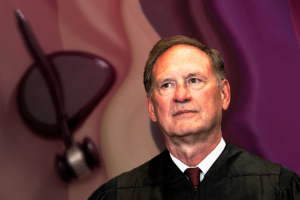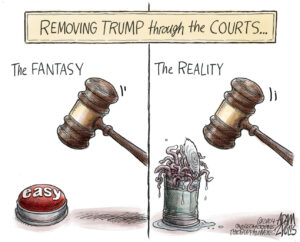Examining the Death Penalty
On Dec. 2 Kenneth Boyd was executed by the state of North Carolina, becoming the 1,000th person to be executed since the 1976 Supreme Court ruling Gregg v. Georgia reinstated capital punishment in the United States.On Dec. 2, Kenneth Boyd was executed by the state of North Carolina, becoming the 1,000th person to be executed since the 1976 Supreme Court ruling Gregg v. Georgia reinstated capital punishment in the United States.
Capital punishment has a long history.
As of Dec. 2, 57 people had been executed in the United States this year. Stanley Tookie Williams was executed on Dec. 13, 2005 after his request for clemency was denied. There are currently five executions scheduled before the close of the year, four of these executions were recently stayed.
Executions have not been consistently supported by the Supreme Court and ceased for a short time after the Furman v. Georgia ruling in 1972, in which the “imposition and carrying out of death penalty … [was] held to constitute cruel and unusual punishment in violation of Eighth and 14th Amendments.” The same ruling also cited a presidential commission that noted: ” …there is evidence that the imposition of the death sentence and the exercise of dispensing power by the courts and the executive follow discriminatory patterns. The death sentence is disproportionately imposed and carried out on the poor, the Negro, and the members of unpopular groups.” This ruling put an end to capital punishment in the U.S until 1976, when the Supreme Court issued a decision in Gregg v. Georgia that essentially reinstated the death penalty.
DEATH PENALTY FACTS
- As of Dec. 2, 57 people had been executed in 2005 in the United States.
- At least six more executions are scheduled before the end of 2005.
- Between 1976 and January 2005, 22 juvenile offenders were executed in the U.S.
- In March 2005 the Supreme Court decided in Roper v. Simons to end the practice of putting to death people who committed crimes as juveniles.
- In June 2002 the Supreme Court ruled in Atkins v. Virginia that it is a violation of the Eighth Amendment ban on cruel and unusual punishment to execute death row inmates who are mentally retarded.
- Mental illness is not grounds for exclusion from punishment by death.
According to Amnesty International:
“During 2004, more than 3,797 people were executed in 25 countries and at least 7,395 were sentenced to death in 64 countries.
“A few countries accounted for the majority of executions carried out during 2004. China executed at least 3,400 people, but sources inside the country have estimated the number to be near 10,000.
“Iran executed at least 159, and Vietnam at least 64. There were 59 executions in the United States, down from 65 in 2003.”
Amnesty International also has a page with executions by state.
General information about the death penalty is available from the Death Penalty Fact Sheet (.pdf) by the Death Penalty Information Center
MAJOR SUPREME COURT DECISIONS PERTAINING TO THE DEATH PENALTY
on NPR site available along with audio by Nina Totenberg:
1968, Witherspoon v. Illinois Holds that opposition to the death penalty is insufficient cause for exclusion from the jury: “A man who opposes the death penalty, no less than one who favors it, can make the discretionary choice of punishment entrusted to him by the State and can thus obey the oath he takes as a juror; but in a nation where so many have come to oppose capital punishment, a jury from which all such people have been excluded cannot perform the task demanded of it — that of expressing the conscience of the community on the ultimate question of life or death. P. 519.”
1971, McGautha v. California Decision regarding whether defendants’ rights are “infringed by permitting the death penalty without standards to govern its imposition.” The decision holds: “In light of history, experience, and the limitations of human knowledge in establishing definitive standards, it is impossible to say that leaving to the untrammeled discretion of the jury the power to pronounce life or death in capital cases violates any provision of the Constitution. Pp. 196-208.”
1972,%20Furman%20v.%20Georgia%20%0AThe%20court%20rules%20the%20death%20penalty%20does%20not%20violate%20the%20Constitution,%20but%20the%20manner%20of%20its%20application%20in%20many%20states%20does.%20The%20court%20notes%20capital%20punishment%20was%20likely%20to%20be%20imposed%20in%20a%20discriminatory%20way%20and%20that%20blacks%20were%20far%20more%20likely%20to%20be%20executed%20than%20whites.%20The%20decision%20essentially%20ends%20the%20practice%20of%20executions.%0A%0A
1987, McCleskey v. Georgia Justices rule state death penalty laws are constitutional even when statistics indicate they have been applied in racially biased ways.
1988, Thompson v. Oklahoma The court decides that people younger than 16 when they committed a capital crime may not be executed.
2002, Atkins v. Virginia Justices rule that executing mentally retarded criminals violates the Constitution’s ban on cruel and unusual punishment. Writing for the majority, Justice John Paul Stevens cites a “national consensus” against executing a killer who may lack the intelligence to fully understand his crime.
2005, Roper v. Simmons The court rules the Constitution forbids the execution of killers who were under 18 when they committed their crimes, ending a practice used in 20 states. Justice Anthony Kennedy cites a “national consensus” against the practice.
DEATH PENALTY IN OTHER COUNTRIES
Capital Punishment in the World Today2004
| By Bree Polk-Bauman, for the UN Chronicle Online Edition:
“As defined by the UN Charter, the United Nations was created after the Second World War to prevent unnecessary death, while the Universal Declaration further clarifies that goal, stating in its article 3 that ‘everyone has the right to life’. Since the Declaration’s ratification in December 1948, 118 Member States have abolished the death penalty, either in law or in practice, and many States are encouraging others to abolish it as well.
“Thus, in 1966, the International Covenant on Civil and Political Rights (ICCPR) was adopted, entering into force ten years later; it now has 152 ratifications. The Covenant strongly encourages all UN Member States to abolish the death penalty, but allows that the ‘sentence of death may be imposed only for the most serious crimes’ (Article 6, Section 2). It also created a monitoring body, the Human Rights Committee, as a mechanism to monitor the implementation of the Covenant.
“China, Pakistan, Yemen and Zimbabwe have recently raised the minimum age to 18 years for the application of the death penalty, and Iran is in the process of doing the same. However, the Democratic Republic of Congo, Nigeria, Saudi Arabia, and the United States still have not outlawed the execution of child offenders. Since 1990, over half of such known executions of child offenders (19 of the 36) have taken place in the United States. On 19 July 2004, former Presidents Jimmy Carter of the United States and Mikhail Gorbachev of the Russian Federation, along with several other Nobel Peace Prize laureates, lobbied outside the United States Supreme Court in Washington D.C. in an effort to end the execution of child offenders.”
International Covenant on Civil and Political Rights (ICCPR)Universal Declaration of Human Rights, 1948 The European Union’s Human Rights & Democratization PolicyInfo
| Abolition of the death penalty is a requirement for countries seeking EU membership. “All candidate countries (see regular reports on the accession countries) have acceded to Protocol No. 6 to the European Convention on Human Rights, concerning the abolition of the death penalty. In addition, EU member states are all signatories to Protocol 13 to the convention, concerning the abolition of the death penalty in all circumstances, which was adopted in Vilnius, Lithuania, in May 2002. This treaty explicitly bans the death penalty in all circumstances, including in wartime.” more
RELATED SITES
Capital Punishment Statistics: U.S. Department of JusticeDeath Penalty Information CenterDeath Penalty FocusInnocence ProjectAmnesty International: Death Penaltywww.tookie.com
MULTIMEDIA
This American Life: Backed Into A CornerApril 5, 2005
| “Host Ira Glass interviews Joe Amrine, who was falsely accused of murder. But rather than avoid the death penalty Amrine said everything he could think of on the witness stand to get the jury to give him a death sentence. He figured that would be better than life in prison. Since he would need media attention and free legal help to appeal his case, he calculated the only way he could get it was to sit on death row, because nobody pays attention to lifers. He nearly was executed, and lived on death row for seventeen years before being released…. Joe’s story is a part of the McSweeney’s Voice of Witness Project — Oral Histories of Victims of Contemporary Human Rights Abuses and Social Injustices. The volume on the wrongfully convicted and exonerated is out in October 2005, published by McSweeney’s Books.” more
This American Life: Perfect Evidence April 4, 2002 | “After a decade in which DNA evidence has freed over 100 people nationwide, it’s become clear that DNA evidence isn’t just proving wrongdoing by criminals, it’s proving wrongdoing by police and prosecutors. In this show, we look at what DNA has revealed to us: how police get innocent people to confess to crimes they didn’t commit, how they get witnesses to pin crimes on innocent people. There have always been suspicions that these kinds of things take place. With DNA there’s finally irrefutable proof.” more
After Innocence Film | Directed, written and produced by Jessica Sanders and Marc Simon, “After Innocence” tells the dramatic and compelling story of the exonerated — innocent men wrongfully imprisoned for decades and then released after DNA evidence proved their innocence. The film focuses on the gripping stories of seven men and their emotional journeys back into society and efforts to rebuild their lives. Included are a police officer, an Army sergeant and a young father sent to prison and even death row for decades for crimes they did not commit. more
Your support matters…Independent journalism is under threat and overshadowed by heavily funded mainstream media.
You can help level the playing field. Become a member.
Your tax-deductible contribution keeps us digging beneath the headlines to give you thought-provoking, investigative reporting and analysis that unearths what's really happening- without compromise.
Give today to support our courageous, independent journalists.






You need to be a supporter to comment.
There are currently no responses to this article.
Be the first to respond.